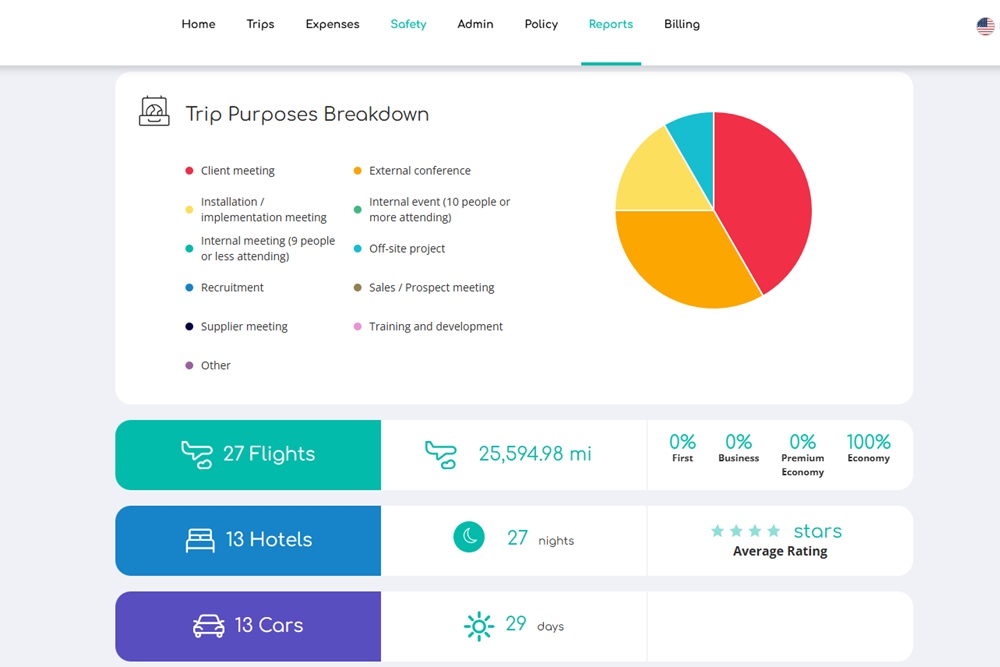Corporate data analytics may sound like a cliche but it’s without a doubt one of the most important aspects of ensuring that your business travel is working for you instead of against your bottom line. Understanding past and current travel trends is like the fuel to your business travel program. It’s what helps you be more conscious and better predict where to best allot your travel budget to see the best results.
This kind of data is fundamental to improve budgeting, forecasting and making more sustainable travel choices. You can also use this information to live up to your company’s duty of care, ensuring that your travelers’ wellbeing is upheld and at the center of all the decisions your company makes in terms of travel. Happy travelers will be more efficient travelers, it’s as simple as that.
The benefits of travel data analytics
Corporate data analytics play a key role in helping to enforce your travel policy compliance, which ultimately cuts costs, helps make more sustainable travel decisions, identify trends and areas for improvement and see where your budget is going.
Identify trends and make improvements
With corporate data analytics you can identify trends like which departments are spending the most of your travel budget, in particular which individuals, and see where the budget is being used most, whether that be flights, trains, hotels or car rentals.
You can also identify which destinations are important for your travelers, and adapt business travel accordingly. You can understand how employees prefer to book (how far in advance, what kind of transportation, etc.) as well as data on unused tickets. You can also analyze the purpose of trips to understand what is the principal reason for corporate trips within your company, and where your travelers went on those trips.

Improve costs
Travel and expense data can also help you unlock potential cost savings. Imagine you determine a certain part of your budget is always going to premium economy or business seats. To cut costs, you could consider updating your travel policy to unlock some budget for more affordable flights. Or say a large portion of your unused tickets haven’t been benefitted from, you can do an internal campaign to promote the use of these tickets.
Make more sustainable travel decisions
Beyond just improving costs, you can also improve sustainability. Now, more than ever sustainability matters, and you can closely analyze corporate travel data analytics to understand how much CO2 emissions are going to flights. Based on the number of kilos, you can have a baseline from which to educate travelers about the importance of choosing other travel means instead of flights (like trains) when possible.
Boost travel policy compliance
The more travelers you have to manage, the more difficult it is, that’s why when you have a way of reporting on corporate travel data analytics, the better you can manage and enforce travel policy management compliance. You can determine when people are booking out of policy and promote accountability and financial responsibility to avoid non-compliance.
Key travel analytics metrics
There are many key travel analytics metrics that can help you optimize your spend effectively and ensure your organization stays on track in terms of cost per trip, booking rates and travel policy compliance.
Total spend
Total spend is without a doubt one of the most important figures you will want to consider to track all expenses relating to corporate travel. This could be for airfare, accommodation, ground transportation and other costs.
Cost per trip
This metric will help you get insights into how effective your trips have been in terms of overall costs. Once you determine cost effectiveness, you can identify where you might want to improve in the future. You can also identify what are the primary business travel cost centers.
Travel volume
Travel volume is where you can identify how many trips are being taken in any given period. You can also look at what transportation methods are being used, whether that be train, plane or car, and how these statistics vary over time.
Percentage of in-policy booked trips
The percentage of in-policy booked trips helps you understand what percentage of trips are being booked within policy. Chances are if you have an automated travel policy in your platform already the majority of your travelers trips are within travel policy guidelines.
Percentage of cancelled trips
Percentage of cancelled trips is another important metric because it helps gain insight into cost management. Frequent cancellations can lead to a sunk cost, or rather a cost that cannot be recovered due to non-refundable bookings and cancellation fees). If you’re lucky and in the case of the US, you may be able to keep airline tickets in the form of unused tickets for later use, but nonetheless cancelled trips can impact budget planning and allocation.

Learn more
Corporate travel data analytics is the key to greater efficiency
Corporate travel data analytics are a key part of how companies can optimize their travel budgets, improve travel policy compliance and also make more sustainable business travel decisions. Businesses can analyze past and current trends to allocate resources effectively and further identify areas to unlock cost savings. This can also help ensure that travel spend is well-aligned with your company’s overall strategy.
Some key travel metrics such as total spend, cost per trip, travel volume and travel policy compliance can help enhance budgeting, while also providing actionable insights. Furthermore, by keeping an eye on the percentage of canceled trips businesses can mitigate sunk costs and further refine travel policies. By leveraging data, companies can gain greater efficiency, enforce compliance and make sure travel is strategically aligned with financial and sustainability goals.

